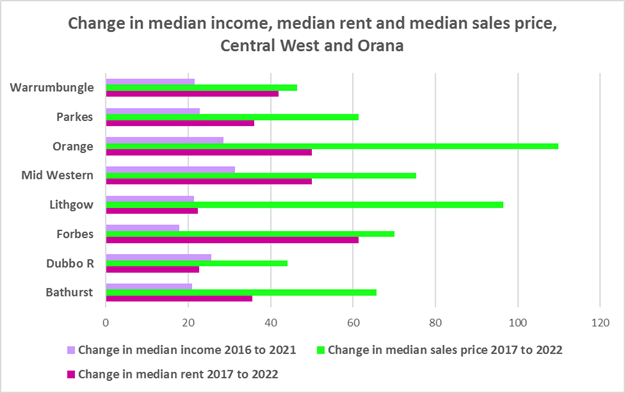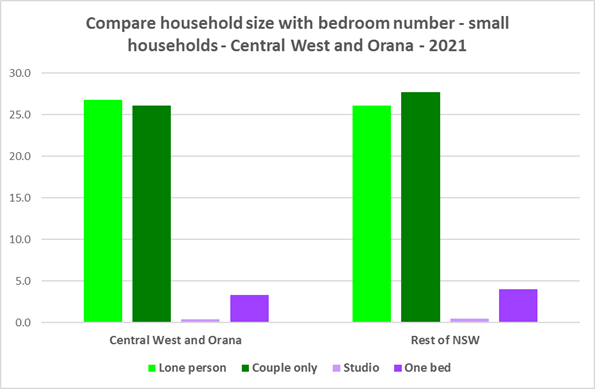Housing Market Snapshot - Central West and Orana Region
The Housing story in the Central West and Orana
The Central West and Orana region is comprised of the nineteen local government areas of Bathurst Regional, Blayney, Bogan, Cabonne, Coonamble, Cowra, Forbes, Gilgandra, Lachlan, Lithgow, Mid-Western Regional, Narromine, Oberon, Orange, Parkes, Warren, Warrumbungle, Weddin and Dubbo/Western Plains Regional. This region includes the major centres of Bathurst, Dubbo and Orange, the key centres of Lithgow, Mudgee and Cowra, as well as Parkes and Forbes.
As with the rest of NSW, the Central West and Orana has had a low vacancy rate for some time, indicating a tight rental market and impacting access to and affordability of private rental. While this region is more affordable than coastal areas of NSW, rents are rising here too and there are increasing numbers of rental households in stress.
What’s the housing demand?
The population is growing, older age groups and smaller households are increasing as is likely housing demand for studio, one and two bedroom homes. Low income households predominate and are increasing in number along with moderate income households.
Between 2016 and 2021, the population of the Central West and Orana grew by 4.0%. This overall growth for the region masks significant differences in the experience of population change in individual LGAs within the region. On an individual LGA basis, population growth ranged from 9.7% in Dubbo Regional to -8.3% in Bogan.
Not unexpectedly, the larger regional centres of Dubbo Regional, Bathurst and Orange tend to have more teenagers and younger adults, while many of the smaller more rural LGAs have higher proportions of aged and/or frail aged – including Weddin and Warrumbungle as well as Bogan, Cowra, Forbes, Gilgandra, Lachlan, Lithgow, Narromine, Oberon, Parkes and Warren. Generally the region has higher proportions of 0-14, 55-64 and 75-84 year olds and lower proportions of 25-44 year olds than the average for the Rest of NSW. The region requires a range of housing to suit different housing needs throughout the housing life cycle.
For the Central West and Orana region as a whole, lone person households are the largest household type (26.8%) along with couple families without children (26.1%), although there is variation between LGAs within the region. This suggests demand for smaller homes.
At the 2021 Census, low income households comprise the largest proportion of all households in the Rest of NSW, in the Central West and Orana as a whole and each Central West and Orana LGA, with the exception of Bogan. Between 2016 and 2021 in the Central West and Orana region, low and moderate income households increased while the number of high income households actually declined. This implies most housing needs to be affordable for lower income households.
What’s happening in the market?
Housing market conditions and rent and purchase affordability varies significantly within the region, particularly between the larger centres and the rest of the region. There are declining numbers of affordable rental properties, the rental market is very tight, rents are rising and there are higher numbers of lower income rental households in housing stress.
There have been strong increases in median rents in the Central West and Orana region for a couple of decades. However, the period from 2019 to 2022 has been more varied and complex, with declines or little change in median rents between 2019 and 2020 and strong increases from 2020 to 2022.
At March 2023 the vacancy rate in both the Central West and Orana was 1.7%. Vacancy rates are tight across both regional and metropolitan New South Wales, with for example New England having a vacancy rate of 1.6% at March 2023, the Riverina 0.9%, Murrumbidgee 1.4%, Albury 0.5% and Sydney 1.3%.
Overall, between 2016 and 2021, the proportion of both very low and low income households in rental stress across the Central West and Orana increased by greater margins than the average for the Rest of NSW. At the same time there have been significant reductions in the number of new rental bonds lodged which are affordable to low income households – indicating that rents are moving beyond the reach of lower income households – and therefore represent a loss of affordable private rental.
The long term median sales price trend for houses and flats shows growth across all LGAs. Between March 2021 and March 2022 there was strong growth in median house prices. Increases in the median sales price for houses ranged between 42.5% in Lithgow and 13.3% in Blayney. At the same time there have been declines in purchase affordability for very low and low income households in the Central West and Orana. 38.3% of very low and low income purchasers in Central West and Orana are in housing stress - although there are significantly more very low and low income renters in stress than purchasers.
What’s happening with supply – and is it a good match?
The majority of households in the Central West and Orana are lone person or couple households, yet the housing stock is overwhelmingly detached homes with three or four bedrooms. This housing was built at a time when families were the predominant household type and this is no longer the case in most local government areas. Generally the region has insufficient diversity in housing type or bedroom mix and the mismatch will worsen, particularly given the forecast for an increase in older age cohorts, unless proactive measures are taken to increase the supply of smaller dwellings.
88.8% of all occupied dwellings in the Central West and Orana are separate houses, compared to 82.5% in the Rest of NSW. More importantly, 40.0% of dwellings have three bedrooms and a further 39.3% have four or more bedrooms. Only 0.4% of homes are studios, 3.3% have one bedroom and 15.0% have two bedrooms in the Central West and Orana.
Given that lone person and couple only households comprised 51.4% of all households in the Central West and Orana, the fact that studio and one bedroom homes combined comprise just 3.7% of the housing stock shows a significant mismatch between household type and dwelling size and an extraordinary lack of housing choice for smaller households.
The forecast increase in older age groups in the region is likely to increase the demand for smaller homes. It is important for older residents to be able to downsize from larger family dwellings to smaller dwellings that are easier to manage and in which they may retain their independence. Two bedroom dwellings in particular offer the most flexibility, given they are also suitable for small families and allow older residents to have family members or carers to stay while giving them a more manageable size home to maintain.
There is a clear need for more affordable rental accommodation to begin to address the demand supply imbalance, particularly for lower income households and the increasing number of seniors and frail aged. Considered together, the strong increase in rental levels, decline in rental affordability for lower income earners and decline in affordable rental properties, combined with the increase in low income households, demonstrates the need to increase the supply of affordable housing.
Change 2016 to 2021

Note that data was not available for every LGA in the Central West and Orana.
Comparative statistics
- Number of dwellings at 2021: 120,893
- Population at 2021: 290,134
- Number of rental households at 2021: 30,255
- The number of Very Low and Low income households at 2021: 55,085
- Number of Very Low and Low income rental households at 2021: 9,091
- Number of Very Low and Low Income Renters in Housing Stress at 2021: 6,153
- Reduction in no. of new bonds lodged affordable to low income households (2017-2022): -71.0%
- Number of New Bonds Lodged Affordable for low income households 2022: 1,110
- Number of Homeless at 2021: 797
- Number of Marginally Housed: 811
Key regional statistics
- Number of lone person households: 31,238
- Number of couple only households: 30,448
- Number of studio dwellings: 461
- Number of one bedroom dwellings: 3,589
- Number of caravan, cabin, houseboat dwellings: 334
- Number of unoccupied dwellings: 13,708

Additional information
Additional information on: